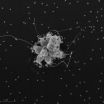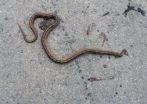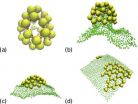(Press-News.org) Bacteria have a bad rap as agents of disease, but scientists are increasingly discovering their many benefits, such as maintaining a healthy gut.
A new study now suggests that bacteria may also have helped kick off one of the key events in evolution: the leap from one-celled organisms to many-celled organisms, a development that eventually led to all animals, including humans.
Published this month in the inaugural edition of the new online journal eLife, the study by University of California, Berkeley, and Harvard Medical School scientists involves choanoflagellates (aka "choanos"), the closest living relatives of animals. These microscopic, one-celled organisms sport a long tail or flagellum, tentacles for grabbing food and are members of the ocean's plankton community. As our closest living relative, choanos offer critical insights into the biology of their last common ancestor with animals, a unicellular or colonial organism that lived and died over 650 million years ago.
"Choanoflagellates evolved not long before the origin of animals and may help reveal how animals first evolved," said senior author Nicole King, UC Berkeley associate professor of molecular and cell biology.
Since first starting to study choanoflagellates as a post-doc, King has been trying to figure out why some choanoflagellates live their lives as single cells, while others form colonies. After years of dead ends, King and undergraduate researcher Richard Zuzow discovered accidentally that a previously unknown species of bacteria stimulates one choanoflagellate, Salpingoeca rosetta, to form colonies. Because bacteria were abundant in the oceans when animals first evolved, the finding that bacteria influence choano colony formation means it is plausible that bacteria also helped to stimulate multicellularity in the ancestors of animals.
"I would be surprised if bacteria did not influence animal origins, since most animals rely on signals from bacteria for some part of their biology," King said. "The interaction between bacteria and choanos that we discovered is interesting for evolutionary reasons, for understanding how bacteria interact with other organisms in the oceans, and potentially for discovering mechanisms by which our commensal bacteria are signaling to us."
No one is sure why choanoflagellates form colonies, said one of the study's lead authors, UC Berkeley post-doctoral fellow Rosanna Alegado. It may be an effective way of exploiting an abundant food source: instead of individual choanoflagellates rocketing around in search of bacteria to eat, they can form an efficient bacteria-eating "Death Star" that sits in the middle of its food source and chows down.
Whatever the reasons, colonies of unicellular organisms may have led the way to more permanent multicellular conglomerations, and eventually organisms comprised of different cell types specialized for specific functions.
Sequencing the choanoflagellate genome
King's 12-year search for the trigger of choanoflagellate colony development was reignited in 2005 when she started to prime cultures of the choanoflagellate S. rosetta for a genome sequencing project. The sequencing of another choanoflagellate, the one-celled Monosiga brevicollis, gave some clues into animal origins, but she needed to compare its genome to that of a colony-forming choanoflagellate.
Surprisingly, when Zuzow tried to isolate the colony-forming choanoflagellate by adding antibiotics to the culture dish to kill off residual bacteria, strange things happened, said King.
"When he treated the culture with one cocktail of antibiotics, he saw a bloom of rosette colony formation," she said, referring to the rose petal-shaped colonies that were floating in the culture media. "When he treated with a different cocktail of antibiotics, that got rid of colony formation altogether."
That "rather mundane but serendipitous observation" led Zuzow and Alegado to investigate further and discover that only one specific bacterial species in the culture was stimulating colony formation. When other bacteria outnumbered it, or when antibiotics wiped it out, colony formation stopped. Alegado identified the colony-inducing bacteria as the new species, Algoriphagus machipongonensis. While she found that other bacteria in the Algoriphagus genus can also stimulate colony formation, other bacteria like E. coli, common in the human gut, cannot.
Working with Jon Clardy of Harvard Medical School, a natural products chemist, the two labs identified a molecule – a fatty acid combined with a lipid that they called RIF-1 – that sits on the surface of bacteria and is the colony development cue produced by the bacteria.
"This molecule may be betraying the presence of bacteria," Alegado said. "Bacteria just sit around blebbing off little membrane bubbles, and if one of them has this molecule, the choanoflagellates all of a sudden say, 'Aha, there are some bacteria around here.'"
The signal sets off a predetermined program in the choanoflagellate that leads to cell division and the development of rosettes, she said. The molecule RIF-1 is remarkably potent; choanos detect and respond to it at densities that are about one billionth that of the lowest concentration of sugar that humans can taste in water.
"We are investigating this molecule from many sides. How and why do bacteria make it? How do choanoflagellates respond to it, and why?" King said. She and her team also are analyzing the genome of the colony-forming choanoflagellate and the colony-inducing bacteria for clues to their interaction.
King hopes that this unexpected signaling between choanoflagellates and bacteria can yield insights into other ways in which bacteria influence biology, particularly the biology of the gut.
INFORMATION:
Coauthors with King, Alegado and Clardy are Zuzow, now a graduate student at Stanford University; Laura Brown, now a faculty member at Indiana University; Shugeng Cao and Renee Dermenjian of Harvard Medical School; and Stephen Fairclough of UC Berkeley. Dermenjian is now at Merck.
The research is funded by the National Institutes of Health and the Gordon and Betty Moore Foundation Marine Microbiology Initiative.
Did bacteria spark evolution of multicellular life?
New study finds bacteria cue single-celled choanoflagellates to form colonies
2012-10-24
ELSE PRESS RELEASES FROM THIS DATE:
JCI early table of contents for Oct. 24, 2012
2012-10-24
The missing "lnc" in human disease
LncRNAs (pronounced "link") are long non-coding RNAs that are emerging as important regulators of gene expression in biological processes and diseases. In this issue of the Journal of Clinical Investigation, two papers connect lncRNAs to inherited conditions in humans. Sylvia Bähring and colleagues at the Experimental and Clinical Research Center in Berlin found a chromosomal translocation that disrupts the expression of a lncRNA. This disruption alters the expression of the genes PTHLH and SOX9 and results in brachydactyly, an inherited ...
The missing 'lnc' in human disease
2012-10-24
LncRNAs (pronounced "link") are long non-coding RNAs that are emerging as important regulators of gene expression in biological processes and diseases. In this issue of the Journal of Clinical Investigation, two papers connect lncRNAs to inherited conditions in humans. Sylvia Bähring and colleagues at the Experimental and Clinical Research Center in Berlin found a chromosomal translocation that disrupts the expression of a lncRNA. This disruption alters the expression of the genes PTHLH and SOX9 and results in brachydactyly, an inherited malformation of the fingers and ...
Reaching the point of no return: Early intervention in a mouse model of obesity
2012-10-24
Obesity is a chronic metabolic disorder that affects half a billion people worldwide. Managing obesity is difficult, as many patients rebound to their pre-treatment weight. There is a hypothesis that chronic weight gain causes the body to adopt a state that supports excess weight. In a study published in the Journal of Clinical Investigation, researchers led by Malcolm Low at the University of Michigan challenged this hypothesis by developing a mouse model of obesity where the proopiomelanocortin (Pomc) gene in the hypothalamus can be turned on and off. With Pomc turned ...
84 million stars and counting
2012-10-24
Using a whopping nine-gigapixel image from the VISTA infrared survey telescope at ESO's Paranal Observatory, an international team of astronomers has created a catalogue of more than 84 million stars in the central parts of the Milky Way. This gigantic dataset contains more than ten times more stars than previous studies and is a major step forward for the understanding of our home galaxy. The image gives viewers an incredible, zoomable view of the central part of our galaxy. It is so large that, if printed with the resolution of a typical book, it would be 9 metres long ...
A 84-million star color-magnitude diagram of the Milky Way bulge
2012-10-24
Astronomy & Astrophysics published the first analysis of a catalog of 84 million individual stars in the Milky Way bulge as a part of the VVV ESO public survey. This gigantic data set allows building the largest, deepest, and most accurate color-magnitude diagram ever produced, containing more than ten times more stars than any previous study.
The bulge of the Milky Way is a large central concentration of ancient stars that is predominantly observed from the southern hemisphere. Understanding the formation and evolution of the bulge is fundamental for deciphering the ...
Herbal and dietary supplements can adversely affect prescribed drugs says extensive review
2012-10-24
A number of herbs and dietary supplements (HDS) can cause potentially harmful drug interactions, particularly among people receiving medication for problems with their central nervous or cardiovascular systems.
Those are the key findings of an extensive research review published in the November issue of IJCP, the International Journal of Clinical Practice.
Researchers examined 54 review articles and 31 original studies. They found that the greatest problems were caused by interactions between prescribed drugs and HDS that included ingredients such as St John's Wort, ...
Mouse model exposes a new type of T cell to target melanoma
2012-10-24
October 24, 2012, New York, NY – Cancers arise in the body all the time. Most are nipped in the bud by the immune response, not least by its T cells, which detect telltale molecular markers—or antigens—on cancer cells and destroy them before they grow into tumors. Cancer cells, for their part, evolve constantly to evade such assassination. Those that succeed become full-blown malignancies. Yet, given the right sort of help, the immune system can destroy even these entrenched tumors.
In the October 22nd issue of the Journal of Experimental Medicine, researchers led by ...
A new take on the Midas touch -- changing the color of gold
2012-10-24
Red gold, green gold – a ground-breaking initiative has found a way of changing the colour of the world's most iconic precious metal.
A University of Southampton team have discovered that by embossing tiny raised or indented patterns onto the metal's surface they can change the way it absorbs and reflects light – ensuring our eyes don't see it as 'golden' in colour at all.
The finding results from a major initiative funded by the Engineering and Physical Sciences Research Council (EPSRC) targeting the development of a new generation of nanotechnology-enabled materials. ...
The majority of roadkill amongst vertebrates in Catalonia are in protected areas
2012-10-24
Amphibians are the vertebrate group that is more likely to become roadkill in Catalonia, even more so than reptiles, mammals and birds. This is the case according to an international team of scientists who have concluded that highly protected areas are home to more cases of animal death on the roads.
Our network of roads is considered one of the main threats to fauna survival. Researchers at the universities of Barcelona (UB), Porto (Portugal) and Uppsala (Sweden) have studied the number of vertebrate deaths on 820 kilometres of road in North Eastern area of Spain and ...
New insights into membrane-assisted self-assembly
2012-10-24
"In our current paper we present new computational results that explore how membranes may influence crucial biological processes", explains Richard Matthews, Lise-Meitner-Fellow at the University of Vienna and first author of the study. The focus of the investigation is the self-assembly of microscopic particles, the formation of structures or patterns without human intervention. More specifically, the effect of the interactions between membranes and proteins, which can influence the formation of ordered structures in cells, is considered.
Self-assembly has become a hot ...
LAST 30 PRESS RELEASES:
University of Oklahoma researcher awarded funding to pursue AI-powered material design
Exploring how the visual system recovers following injury
Support for parents with infants at pediatric check-ups leads to better reading and math skills in elementary school
Kids’ behavioral health is a growing share of family health costs
Day & night: Cancer disrupts the brain’s natural rhythm
COVID-19 vaccination significantly reduces risk to pregnant women and baby
The role of vaccination in maternal and perinatal outcomes associated with COVID-19 in pregnancy
Mayo Clinic smartwatch system helps parents shorten and defuse children's severe tantrums early
Behavioral health spending spikes to 40% of all children’s health expenditures, nearly doubling in a decade
Digital cognitive behavioral treatment for generalized anxiety disorder
Expenditures for pediatric behavioral health care over time and estimated family financial burden
Air conditioning in nursing homes and mortality during extreme heat
The Alps to lose a record number of glaciers in the next decade
What makes a good proton conductor?
New science reporting guide published for journalists in Bulgaria
New international study reveals major survival gaps among children with cancer
New science reporting guide published for journalists in Turkey
Scientists develop a smarter mRNA therapy that knows which cells to target
Neuroanatomy-informed brain–machine hybrid intelligence for robust acoustic target detection
Eight SwRI hydrogen projects funded by ENERGYWERX
The Lundquist Institute and its start-up company Vitalex Biosciences Announces Strategic Advancement of Second-Generation fungal Vaccine VXV-01 through Phase 1 Trials under $40 Million Competitive Con
Fine particles in pollution are associated with early signs of autoimmune disease
Review article | Towards a Global Ground-Based Earth Observatory (GGBEO): Leveraging existing systems and networks
Penn and UMich create world’s smallest programmable, autonomous robots
Cleveland researchers launch first major study to address ‘hidden performance killer’ in athletes
To connect across politics, try saying what you oppose
Modulating key interaction prevents virus from entering cells
Project explores barriers to NHS career progression facing international medical graduates
Jeonbuk National University researchers explore the impact of different seasonings on the flavor perception of Doenjang soup
Two Keck Medicine of USC Hospitals named Leapfrog Top Teaching Hospitals
[Press-News.org] Did bacteria spark evolution of multicellular life?New study finds bacteria cue single-celled choanoflagellates to form colonies



